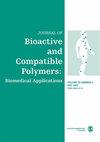作为潜在牙周炎治疗药物的水杨酸盐基聚合物和包封洗必泰的双重药物释放特征
IF 2.2
4区 生物学
Q3 BIOTECHNOLOGY & APPLIED MICROBIOLOGY
引用次数: 0
摘要
由于水杨酸(SA)会在聚合物降解过程中释放出来,因此水杨酸基聚酸酐酯(SAPAEs)具有伤口愈合特性。此外,这种聚合物在体温下具有低杨氏模量、较低的玻璃转化温度(Tg)和固有的粘性,因此可变形并具有自粘性。这些特性使它们特别适合在口腔细菌密集的环境中进行治疗。为了增强其治疗能力,我们在 SAPAE 中加入了防腐剂盐酸洗必泰,以便在降解时实现防腐和消炎的双重释放。本研究分析了两种 SAPAE 组合物(己二酸酯均聚物和 50:50 己二酸酯:癸二酸酯共聚物)的热力学特性,以及这些聚合物中洗必泰(含量为 10%(重量比))的释放情况。聚合物的粘附性随洗必泰的掺入量和体外降解时间而变化。在整个体外降解过程中,聚合物系统的杨氏模量较低,Tg 值为体温或接近体温。防腐剂的加入进一步降低了杨氏模量,提高了 Tg 和粘附性。此外,还对均聚物和共聚物的释放曲线进行了评估,结果表明两者的释放曲线相似,但均聚物的降解时间更长。总之,SAPAE 系统具有可控的降解性、变形性、粘附性和封装防腐剂的释放曲线,因此具有治疗牙周病的良好特性。本文章由计算机程序翻译,如有差异,请以英文原文为准。
Dual drug release profiles of salicylate-based polymers and encapsulated chlorhexidine as potential periodontitis treatments
Salicylate-based poly(anhydride-esters; SAPAEs) have demonstrated wound healing properties due to salicylic acid (SA) release during polymer degradation. Additionally, the polymers are deformable and self-adhesive due to their low Young’s modulus, lower glass transition temperature ( Tg ), and inherent tackiness at body temperature. These properties make them particularly well-suited for therapeutic use in the bacteria-laden environment of the oral cavity. To enhance their therapeutic capabilities, the antiseptic chlorhexidine dihydrochloride was physically incorporated into SAPAEs for dual release of antiseptic and anti-inflammatory upon degradation. This study analyzes the thermomechanical properties of two SAPAE compositions (adipate homopolymer and 50:50 adipate:sebacate copolymer) and the release of chlorhexidine (incorporated at 10% (w/w)) from these polymers. Polymer adhesivity was monitored as a function of chlorhexidine incorporation and in vitro degradation time. Throughout in vitro degradation, the polymer systems had a low Young’s modulus and a Tg at or near body temperature. Incorporation of the antiseptic further decreased Young’s modulus and increased both the Tg and adhesivity. The release profiles were also evaluated and determined to be similar for the homopolymer and copolymer, although the homopolymer degradation occurred over a longer time period. Overall, the SAPAE systems have favorable properties for periodontal disease treatments by virtue of their controlled degradability, deformability, adhesivity, and release profiles with encapsulated antiseptic.
求助全文
通过发布文献求助,成功后即可免费获取论文全文。
去求助
来源期刊

Journal of Bioactive and Compatible Polymers
工程技术-材料科学:生物材料
CiteScore
3.50
自引率
0.00%
发文量
27
审稿时长
2 months
期刊介绍:
The use and importance of biomedical polymers, especially in pharmacology, is growing rapidly. The Journal of Bioactive and Compatible Polymers is a fully peer-reviewed scholarly journal that provides biomedical polymer scientists and researchers with new information on important advances in this field. Examples of specific areas of interest to the journal include: polymeric drugs and drug design; polymeric functionalization and structures related to biological activity or compatibility; natural polymer modification to achieve specific biological activity or compatibility; enzyme modelling by polymers; membranes for biological use; liposome stabilization and cell modeling. This journal is a member of the Committee on Publication Ethics (COPE).
 求助内容:
求助内容: 应助结果提醒方式:
应助结果提醒方式:


